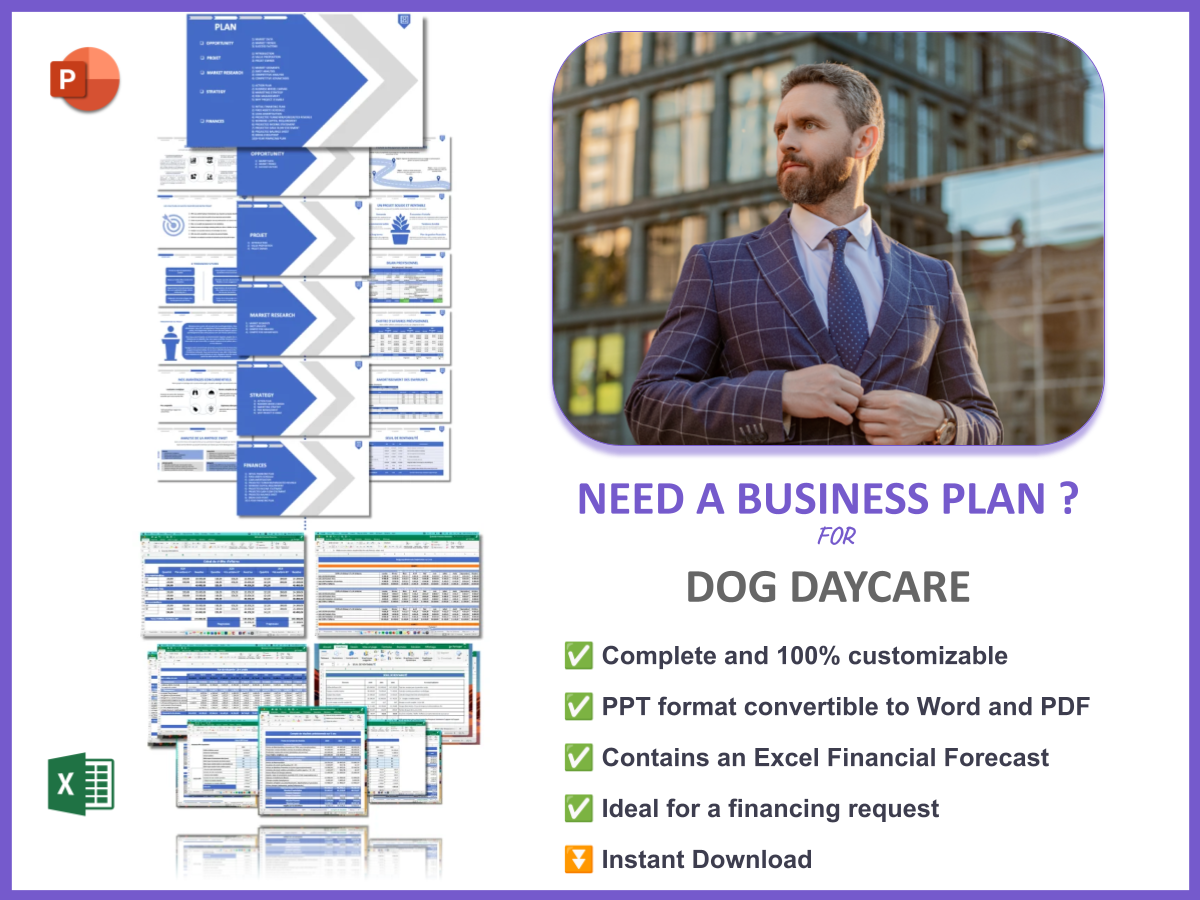Are you thinking about starting a dog daycare marketing plan? You’re not alone! The pet care industry is booming, with over 67% of U.S. households owning a pet, and many of those households are looking for reliable daycare services for their furry friends. A well-structured dog daycare marketing plan is essential for standing out in this competitive market.
Defining your target market is crucial for any dog daycare marketing plan. Knowing who your customers are will help tailor your services to meet their needs. You can segment your market based on various factors like demographics and psychographics.
1. Define Your Target Market
| Aspect | Details |
|---|---|
| Demographics | Age, income, location |
| Psychographics | Interests, lifestyle choices |
Start by gathering data on your potential customers. Here are some aspects to consider:
- Age: What age groups are most likely to use your services?
- Income: What income levels can afford your daycare services?
- Location: Are you targeting urban, suburban, or rural areas?
Once you have this data, you can create customer personas to visualize who you are marketing to. For instance, if your daycare is located in a busy city, your target market may include young professionals with disposable income who are looking for quality care for their pets while they work.
2. Understand Your Ideal Customers
| Customer Type | Characteristics |
|---|---|
| Busy Professionals | Need flexible hours, convenience |
| Families | Looking for safe, fun environments |
Once you know your target market, dive deeper to understand your ideal customers. What are their specific needs and preferences? This insight will guide your marketing messages and service offerings.
Consider conducting surveys or interviews to gather qualitative data about your customers. Here are some questions you might ask:
- What factors do you consider when choosing a dog daycare?
- What services are most important to you?
- How do you prefer to receive information about dog care services?
Understanding these elements will help you tailor your services and marketing strategies to better meet your customers’ needs. For instance, if families express a need for after-school care for their pets, you might consider offering extended hours or special programs that cater to that demographic.
3. Analyze Your Competitors
| Competitor | Strengths | Weaknesses |
|---|---|---|
| Competitor A | Established brand, loyal customer base | Limited services |
| Competitor B | Wide range of services, experienced staff | Poor customer service |
Analyzing your competitors is essential in crafting an effective dog daycare marketing plan. Start by identifying who your main competitors are in the local market. Understanding their strengths and weaknesses can provide you with valuable insights into how you can differentiate your services.
Here are some key points to consider while analyzing competitors:
- Service Offerings: What services do they provide? Are there any gaps you can fill?
- Pricing: How do their prices compare to yours? Are they competitive?
- Customer Reviews: What do customers say about their experiences? Look at online reviews to gauge public perception.
By understanding the landscape, you can position your daycare as a better alternative. For example, if you notice a competitor lacks social media presence, you can capitalize on that by creating engaging content and building a strong online community.
4. Establish Clear Marketing Objectives for Your Dog Daycare Marketing Plan
| Objective | Measurement |
|---|---|
| Increase brand awareness | Social media engagement metrics, website traffic |
| Boost customer retention | Monthly repeat bookings, customer feedback |
Your marketing objectives should be SMART: Specific, Measurable, Achievable, Relevant, and Time-bound. This clarity will help guide your efforts and measure your success.
Consider setting the following objectives:
- Increase Brand Awareness: Aim for a 20% increase in social media followers over the next six months.
- Boost Customer Retention: Strive for a 15% increase in repeat bookings each month.
- Enhance Customer Engagement: Conduct monthly surveys to gather feedback and improve services.
By establishing clear marketing objectives, you can focus your efforts on what truly matters. For instance, if your goal is to increase brand awareness, you might invest more in social media advertising or community events. This structured approach ensures that every marketing activity is aligned with your overall business goals.
5. Choose Effective Marketing Strategies for Your Dog Daycare Marketing Plan
| Strategy | Details |
|---|---|
| Social Media Marketing | Engaging posts, pet photos, contests |
| Email Campaigns | Monthly newsletters, special promotions |
Picking the right strategies is vital for your dog daycare marketing plan. A mix of digital and traditional marketing methods can help you reach your audience effectively. Here are some strategies to consider:
- Social Media Marketing: Create engaging content that showcases your daycare. Share photos of happy dogs, host contests, and engage with your audience through comments and messages.
- Email Campaigns: Develop a monthly newsletter that includes tips for pet care, updates about your daycare, and special promotions. This keeps your customers informed and engaged.
- Local Partnerships: Collaborate with local pet stores, veterinarians, and dog trainers to cross-promote services. This can expand your reach within the community.
Remember to track the performance of each strategy. For instance, if social media posts are generating more inquiries than email campaigns, you may want to allocate more resources to your social media efforts.
6. Evaluate and Adjust Your Approach
| Metric | Evaluation Method |
|---|---|
| Website Traffic | Google Analytics, user behavior tracking |
| Customer Feedback | Surveys, reviews analysis |
Regular evaluation of your marketing efforts allows for necessary adjustments. Use data to see what’s working and what needs improvement. Consider the following:
- Website Traffic: Use tools like Google Analytics to monitor how many visitors your site receives and which pages they visit. Are they finding the information they need?
- Customer Feedback: Regularly gather customer feedback through surveys or online reviews. This will help you understand their experiences and areas where you can improve.
Don’t be afraid to pivot your strategies based on this data. For example, if customer feedback indicates a desire for more interactive activities, consider adding playdates or training sessions. The more you adapt to your customers’ needs, the more successful your dog daycare marketing plan will be.
7. Example N°1 of Marketing Plan for Dog Daycare
| Steps | Actions | Details |
|---|---|---|
| 1 | Target Market | Identify demographics and interests of pet owners in your area. |
| 2 | Ideal Customers | Focus on young professionals and families with pets. |
| 3 | Competitors | Analyze local daycare options and their service offerings. |
| 4 | Marketing Objectives | Increase social media followers by 25% in 3 months. |
| 5 | Marketing Strategies | Implement a referral program to encourage word-of-mouth. |
| 6 | Evaluation | Track new client sign-ups monthly and assess marketing effectiveness. |
This example outlines a basic structure for a dog daycare marketing plan. Start by defining your target market, which in this case focuses on demographics and interests of pet owners in your area. Then, identify your ideal customers, such as young professionals and families who are likely to need daycare services.
Next, analyze your competitors to understand their offerings and pricing. Set measurable marketing objectives, like increasing social media followers by 25% within three months. Consider implementing a referral program as a marketing strategy to leverage word-of-mouth advertising. Finally, regularly evaluate your progress by tracking new client sign-ups to ensure your marketing efforts are effective.
8. Example N°2 of Marketing Plan for Dog Daycare
| Steps | Actions | Details |
|---|---|---|
| 1 | Target Market | Research local pet ownership statistics and trends. |
| 2 | Ideal Customers | Identify tech-savvy pet owners interested in premium services. |
| 3 | Competitors | Evaluate online presence and customer engagement of competitors. |
| 4 | Marketing Objectives | Achieve a 30% increase in inquiries through website within 6 months. |
| 5 | Marketing Strategies | Develop targeted online ads focusing on premium services. |
| 6 | Evaluation | Analyze website traffic and customer feedback monthly. |
This second example illustrates a different approach to a dog daycare marketing plan. Begin with researching local pet ownership statistics to understand your target market better. Identify your ideal customers, like tech-savvy pet owners who are more likely to seek premium services.
Next, evaluate the online presence and customer engagement of your competitors to identify gaps you can fill. Set ambitious marketing objectives, such as achieving a 30% increase in inquiries through your website within six months. Develop targeted online ads that highlight your premium services to attract your desired customer base. Lastly, regularly analyze website traffic and customer feedback to fine-tune your strategies and ensure they resonate with your audience.
9. Example N°3 of Marketing Plan for Dog Daycare
| Steps | Actions | Details |
|---|---|---|
| 1 | Target Market | Survey local pet owners to gather insights. |
| 2 | Ideal Customers | Focus on dog owners who prioritize pet safety and socialization. |
| 3 | Competitors | Identify unique services offered by competitors. |
| 4 | Marketing Objectives | Increase customer referrals by 40% within 4 months. |
| 5 | Marketing Strategies | Host community events to showcase services and engage with pet owners. |
| 6 | Evaluation | Measure referral rates and event attendance after each event. |
This example outlines a proactive approach for a dog daycare marketing plan. Begin by surveying local pet owners to gather valuable insights about their needs and preferences. Focus on identifying your ideal customers, particularly dog owners who prioritize pet safety and socialization, as they are more likely to seek daycare services.
Next, identify unique services offered by your competitors to differentiate your daycare. Set a marketing objective to increase customer referrals by 40% within four months. One effective strategy could be to host community events that allow potential customers to experience your services firsthand while engaging with pet owners. Finally, evaluate your success by measuring referral rates and attendance at each event to see what resonates with your audience.
10. Example N°4 of Marketing Plan for Dog Daycare
| Steps | Actions | Details |
|---|---|---|
| 1 | Target Market | Analyze pet ownership trends in your area. |
| 2 | Ideal Customers | Identify dog owners who frequently travel for work. |
| 3 | Competitors | Assess pricing and service variety of local daycares. |
| 4 | Marketing Objectives | Achieve a 25% increase in first-time customers in 3 months. |
| 5 | Marketing Strategies | Launch targeted ads on social media focusing on travel needs. |
| 6 | Evaluation | Track the number of first-time customers through booking systems. |
This fourth example provides insights into a strategic dog daycare marketing plan. Start by analyzing pet ownership trends in your area to better understand your target market. Focus on identifying dog owners who frequently travel for work, as they may require daycare services more than others.
Next, assess the pricing and service variety offered by local competitors to ensure your offerings are competitive. Set a marketing objective to achieve a 25% increase in first-time customers within three months. An effective strategy could be launching targeted ads on social media that highlight your daycare’s convenience for busy travelers. Finally, evaluate your success by tracking the number of first-time customers through your booking systems, ensuring your marketing efforts are aligned with customer needs.
11. Example N°5 of Marketing Plan for Dog Daycare
| Steps | Actions | Details |
|---|---|---|
| 1 | Target Market | Identify dog owners interested in training services. |
| 2 | Ideal Customers | Focus on new dog owners seeking guidance. |
| 3 | Competitors | Review training programs offered by local competitors. |
| 4 | Marketing Objectives | Increase enrollment in training programs by 50% in 5 months. |
| 5 | Marketing Strategies | Offer free introductory training classes to attract new clients. |
| 6 | Evaluation | Monitor enrollment numbers and customer satisfaction surveys. |
This example illustrates a focused approach for a dog daycare marketing plan. Start by identifying dog owners who are interested in training services, particularly new dog owners who may be looking for guidance. Understanding this target market will help tailor your offerings effectively.
Next, review the training programs offered by local competitors to ensure your services stand out. Set an ambitious marketing objective to increase enrollment in your training programs by 50% within five months. A strategic way to attract new clients could be to offer free introductory training classes, which can showcase your expertise and help build trust with potential customers. Finally, evaluate your success by monitoring enrollment numbers and gathering feedback through customer satisfaction surveys to continuously improve your services.
12. Example N°6 of Marketing Plan for Dog Daycare
| Steps | Actions | Details |
|---|---|---|
| 1 | Target Market | Identify dog owners in urban areas needing daycare. |
| 2 | Ideal Customers | Focus on city dwellers with busy lifestyles. |
| 3 | Competitors | Analyze urban daycare facilities and their services. |
| 4 | Marketing Objectives | Grow customer base by 30% in 6 months. |
| 5 | Marketing Strategies | Utilize local SEO to attract urban customers searching for daycare. |
| 6 | Evaluation | Assess website traffic and new customer inquiries monthly. |
This example focuses on urban dog owners for your dog daycare marketing plan. Begin by identifying the specific needs of dog owners in urban areas, particularly those with busy lifestyles who may require daycare services during work hours. This understanding will help you tailor your marketing approach.
Next, analyze urban daycare facilities to see what services they provide and how you can differentiate yourself. Set a marketing objective to grow your customer base by 30% within six months. One effective strategy could be to utilize local SEO to improve your visibility for urban customers searching for daycare services online. Finally, regularly assess your website traffic and new customer inquiries to gauge the effectiveness of your marketing strategies.
13. Example N°7 of Marketing Plan for Dog Daycare
| Steps | Actions | Details |
|---|---|---|
| 1 | Target Market | Analyze pet demographics in your community. |
| 2 | Ideal Customers | Focus on active dog owners who engage in outdoor activities. |
| 3 | Competitors | Identify outdoor-focused daycare facilities. |
| 4 | Marketing Objectives | Achieve a 20% increase in bookings for outdoor activities in 3 months. |
| 5 | Marketing Strategies | Promote outdoor activities through social media and local events. |
| 6 | Evaluation | Track bookings and participation in outdoor events. |
This final example emphasizes outdoor activities for your dog daycare marketing plan. Start by analyzing pet demographics in your community to understand the preferences of local dog owners. Focus on active dog owners who enjoy outdoor activities, as they are likely to seek daycare services that align with their lifestyle.
Next, identify any competitors that offer outdoor-focused daycare facilities and assess their offerings. Set a marketing objective to achieve a 20% increase in bookings for outdoor activities within three months. A strategic approach could involve promoting these outdoor activities through social media and participation in local events to attract like-minded customers. Finally, evaluate your success by tracking bookings and participation in outdoor events to ensure your marketing efforts are effective and resonate with your target audience.
Conclusion
Creating a successful dog daycare marketing plan involves understanding your target market, setting clear objectives, and employing effective strategies to attract and retain customers. As you navigate the competitive landscape of the pet care industry, having a solid business plan will be invaluable. For a comprehensive resource, check out this business plan template for Dog Daycare that can guide you through the process.
Additionally, if you’re looking for more insights, don’t miss our articles on How to Build a Dog Daycare Business? and How to Create a SWOT Analysis for Dog Daycare. These resources will provide you with further strategies and analysis to enhance your business plan and marketing efforts.
FAQ
- What is a dog daycare marketing plan?
A dog daycare marketing plan is a strategic approach to attract and retain customers for your dog daycare services. It outlines target markets, marketing objectives, strategies, and evaluation methods. - How do I identify my target market for a dog daycare?
To identify your target market, analyze pet demographics in your area, conduct surveys, and observe competitors to understand who needs your services the most. - What marketing strategies work best for dog daycares?
Effective marketing strategies include social media marketing, local partnerships, community events, and email campaigns to engage potential customers and promote your services. - How can I measure the success of my marketing plan?
You can measure the success of your marketing plan by tracking metrics such as website traffic, customer inquiries, social media engagement, and overall sales growth. - What are common challenges in dog daycare marketing?
Common challenges include standing out among competitors, attracting the right customers, and effectively communicating your unique selling propositions. - How often should I evaluate my marketing plan?
Regular evaluations, at least quarterly, allow you to adjust strategies based on performance data and customer feedback, ensuring your marketing efforts remain effective. - What is the importance of customer feedback in a dog daycare?
Customer feedback is crucial for understanding client satisfaction and areas for improvement, helping you tailor services to better meet customer needs. - How can I increase customer referrals for my dog daycare?
Implementing referral programs, offering incentives, and providing excellent service can encourage satisfied customers to refer friends and family. - What role does social media play in dog daycare marketing?
Social media helps build brand awareness, engage with customers, and showcase your services through engaging content, photos, and promotions. - Can I create a marketing plan without prior experience?
Yes, you can create a dog daycare marketing plan without prior experience by researching best practices, utilizing templates, and continuously learning from feedback and results.







